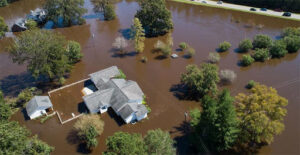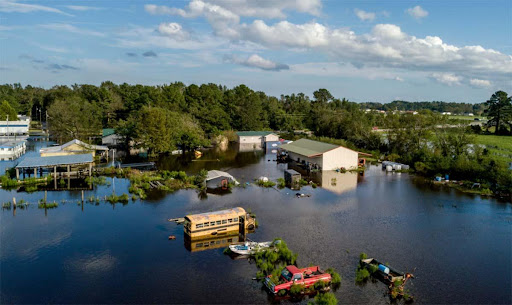North Carolina’s coastal region, known for its scenic beauty and oceanic allure, also grapples with a constant adversary: flooding. Hurricanes, heavy rains, and storm surges pose a recurrent threat, capable of causing significant damage to homes, businesses, and communities.
In this article, we’ll delve into the complexities of flood insurance in this coastal context. Whether you’re a homeowner, renter, or business proprietor, understanding flood insurance is vital for protecting your property and financial stability.
Understanding Floods in North Carolina
 Image Source: USA Today
Image Source: USA Today
Floods in North Carolina come in various forms, including coastal, riverine, and flash floods. Coastal floods often result from hurricanes, while riverine floods occur due to heavy rainfall and overflowing rivers. Flash floods, overwhelming drainage systems, and natural terrain can happen rapidly across the state.
The frequency and severity of flooding vary, with coastal regions at higher risk during hurricane seasons. North Carolina’s diverse geography contributes to these differences, impacting properties, structures, and insurance costs. A grasp of these flood types, their occurrence patterns, and their consequences for coastal properties is essential for residents and property owners in the state.
National Flood Insurance Program (NFIP)
The NFIP is a vital initiative that offers flood insurance coverage to those residing in flood-prone areas across the United States. It partners with insurance providers to provide policies that cover flood-related damages, ensuring financial protection for policyholders.
NFIP policies protect the structure and contents of homes from the devastating impact of floods, making them indispensable for individuals in high-risk regions. One of the significant advantages of NFIP is its affordability, thanks to government support that helps keep premiums reasonable. Furthermore, the program promotes floodplain management practices within communities, potentially reducing flood risks and insurance costs.
Understanding the NFIP, its operation, and its coverage is crucial for residents in flood-prone areas, enabling them to make informed decisions about safeguarding their homes and belongings against flooding.
North Carolina’s Flood Insurance
 Image Source: OleksandrPidvalnyi on Pixabay
Image Source: OleksandrPidvalnyi on Pixabay
North Carolina’s flood insurance landscape is unique, shaped by frequent hurricanes and distinct geography. These factors underline the need for tailored flood insurance solutions in the state. North Carolina actively collaborates with the National Flood Insurance Program (NFIP) to ensure residents have access to appropriate flood insurance options, emphasizing the importance of coverage.
Understanding North Carolina’s flood maps and zones is crucial for residents and property owners. These maps delineate flood risk areas, aiding individuals in assessing their property’s vulnerability and selecting the right level of flood insurance. Staying informed about these maps proactively mitigates risks and protects homes and investments in this dynamic coastal state.
Who Needs Flood Insurance?
The following will benefit greatly from flood insurance:
Coastal Property Owners: Given the heightened risk of flooding in North Carolina’s coastal areas, homeowners near the Atlantic Ocean often require flood insurance to safeguard their investments.
Mortgage Requirements: Federal regulations often mandate flood insurance for homeowners in high-risk flood zones who have mortgages from federally regulated or insured lenders. This ensures lender protection against flood-related losses.
Renters and Flood Insurance: Renters residing in flood-prone regions should consider obtaining flood insurance, as property owner insurance typically does not cover personal belongings.
Businesses and Flood Insurance: Businesses operating in flood-prone zones can protect their assets, equipment, and operations by securing flood insurance, enabling a swifter recovery from flood-related damage. Understanding the relevance of flood insurance for these distinct groups is crucial for comprehensive protection in flood-prone areas.
How to Purchase Flood Insurance
To purchase flood insurance, contact authorized providers participating in the National Flood Insurance Program (NFIP). These providers can tailor policies to your specific needs and location. Consider cost factors like your property’s location, flood risk zone, elevation, and desired coverage amount. Obtain quotes from multiple providers to find a cost-effective option.
Determine your coverage needs by assessing your property’s value, personal belongings, and potential rebuilding costs in case of flood damage. Once you’ve identified your needs and budget, apply for flood insurance through an authorized NFIP insurance agent or company. They’ll assist with paperwork, premium details, and policy terms. Procuring flood insurance proactively is crucial to ensure comprehensive protection for your property and finances.
Flood Insurance Coverage
Flood insurance provides comprehensive coverage for your property. Building coverage safeguards your home’s structural elements, including the foundation, walls, electrical, plumbing, and appliances. Contents coverage protects your personal belongings like furniture and electronics within the property.
It’s essential to be aware of exclusions and limitations in flood insurance policies, which may affect specific areas of your property or types of personal property. Some policies offer additional living expenses (ALE) coverage, assisting with temporary housing and essential expenses if your home becomes uninhabitable due to flood damage. Understanding these aspects helps you customize your policy for comprehensive protection against flood-related risks.
Making a Flood Insurance Claim
 Image Source: Andrea Piacquadio on Pexels
Image Source: Andrea Piacquadio on Pexels
When faced with damages, initiating a flood insurance claim involves several key steps. Firstly, promptly report the flood loss to your insurance provider, providing essential details about the damages and the flood’s circumstances. Documenting the damages is crucial, with photographs and itemized lists helping expedite the claims process.
The claims process typically involves an assessment by an insurance adjuster to determine the coverage amount. Cooperation during this assessment is essential. Policies often include appeals and dispute procedures to ensure a fair resolution of disputes or disagreements. Familiarity with these steps is invaluable for navigating the claims process effectively and securing appropriate compensation in the aftermath of a flood.
Mitigating Flood Risks
Effective flood risk reduction involves several vital strategies. Preparing your property includes drainage improvements and elevating utilities, reducing potential flood damage. Elevating structures above flood levels is a long-term investment that significantly lowers flood risks.
Through zoning and resilient development practices, local community floodplain management contributes to a safer environment. Lastly, incorporating flood-resilient construction methods in new projects and renovations enhances overall flood resilience, benefiting individual properties and the community.
Government Assistance Programs
 Image Source: FEMA
Image Source: FEMA
FEMA, the Federal Emergency Management Agency, extends vital aid to flood-affected individuals and communities, offering grants for housing, repairs, and disaster-related expenses to facilitate recovery.
The Hazard Mitigation Grant Program (HMGP) empowers communities to proactively reduce flood risks through funding projects like flood barriers and infrastructure enhancements.
The Community Rating System (CRS) rewards communities for exceeding floodplain management standards, enabling lower flood insurance premiums through various risk reduction activities.
These government initiatives combine immediate relief with long-term resilience measures to mitigate flood impacts and protect individuals and communities.
Wrapping Up
Flood insurance plays a pivotal role in protecting homes and possessions, while proactive mitigation measures, such as property preparation, elevation, and flood-resilient construction, help reduce the impact of flood events. By staying informed and taking proactive steps, individuals and communities can better prepare for and mitigate the effects of flooding, ensuring the safety and security of North Carolina’s coastal residents and properties.



Leave a Reply